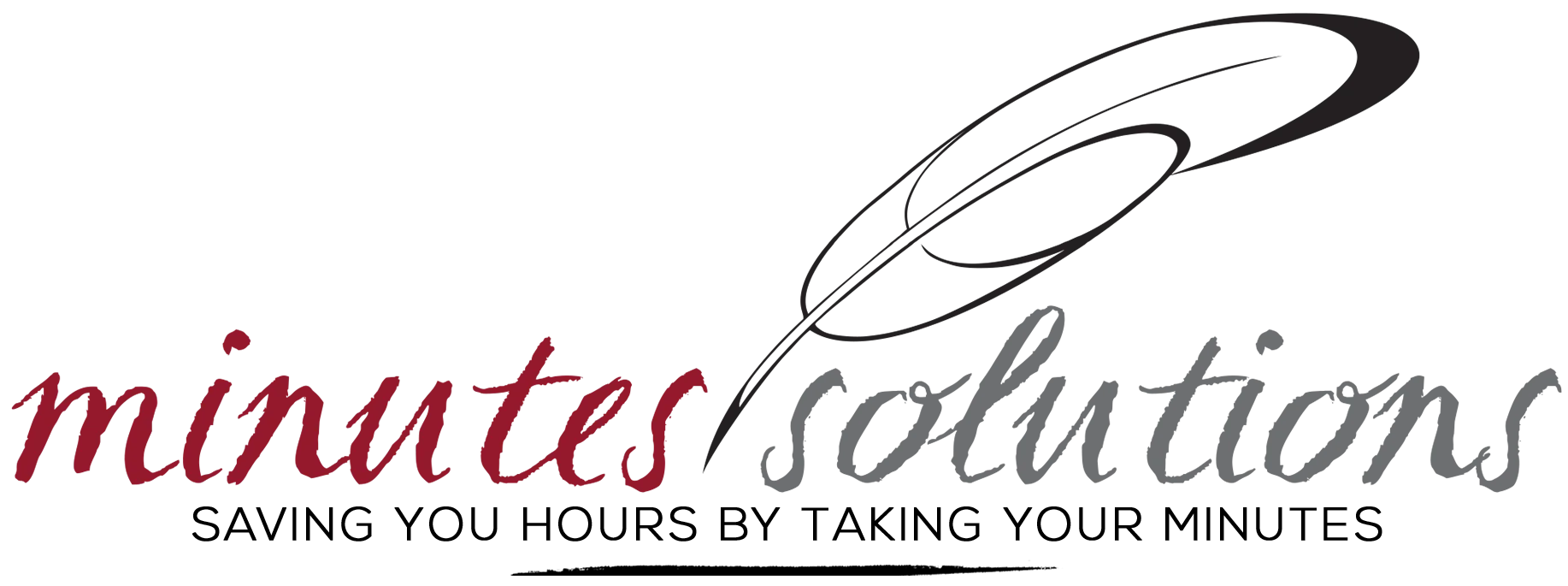Have you ever walked out of a meeting and thought, “Wait, did we actually decide anything?” If so, you are not alone. If referring to the meeting documentation does not answer this question clearly, you likely were relying on meeting notes when what you really needed were meeting minutes.
For any organization, open communication is key. Good communication includes recording the meetings in a standardized and accountable way. Whether you work for a non-profit corporation, serve on the board of a condominium, or hold internal business strategy meetings, consistency is important in how discussions and decisions are recorded.
However, many teams confuse the functions of notes and minutes. These terms are most often used interchangeably, but in practice they are quite different.
Understanding the distinctions between the two can help you maintain compliance, improve governance, and get more out of your meetings—regardless of the meeting type. Accurately recording decisions and discussions also ensures that teams are aligned on expectations, meaning who is doing what, and for what purpose.
What Are Meeting Minutes vs. Meeting Notes?
The “minutes vs. notes” distinction reflects how seriously organizations take their records.
Meeting notes are informal, unstructured records compiled by individuals attending meetings. They tend to be personal. Notes may comprise to-do items, side comments, or personal impressions; there is no mandated formatting, or approval process. Notes are frequently compiled as events occur, with little subsequent editing.
Minutes, on the other hand, are formal, systematic records that—once approved—serve as the official, legal record of a formal meeting, such as a board meeting. Minutes comprise motions, decisions, task assignments, and timelines. Typically, there will also be an assigned person in the meeting, such as a secretary or third-party minute taker, whose role is to accurately and objectively document the meeting.
Who Are Each Option For?
Notes are often for the benefit of an individual: the note taker themselves. Notetakers record reminders, momentary observations, or project ideas. Notes often are not shared, archived in a standard way, or consulted after they are archived.
Minutes, by contrast, serve the group as a whole, which may include board or committee members, executives, auditors, absentees, and counsel. Minutes provide transparency, continuity, and accountability. Minutes are always shared to some degree, and must be properly archived and consulted ahead of the next meeting for approval in the next set of minutes.Notes are often for the benefit of an individual: the note taker themselves. Notetakers record reminders, momentary observations, or project ideas. Notes often are not shared, archived in a standard way, or consulted after they are archived.
How Are They Recorded?
Notes can be recorded in the margins of an agenda, or on a notes app, for example. With notes, people tend to record them in a way that works for the individual note taker.
Minutes, by contrast, frequently depend upon formatting software, version control, and review protocols. Uniformity is achieved with templates. Although AI-assisted transcription programs can create a rough transcript, human review, rewriting, and editing is always required to attain accuracy, neutrality, and readability.
When to Use Meeting Notes, or Meeting Minutes?
Notes are useful for internal brainstorming, casual check-ins, and personal follow-up. They represent individual thoughts, and are not meant to speak for the group. Notes are used to clarify ideas, make sense of next actions, or remember what the individual observed.
Minutes are required for formal meetings such as board meetings, council meetings, committee meetings, and public meetings. They are often required by law or internal governance arrangements, and need to be an accurate, unbiased, and easily accessible record.
In short, when there are decisions to be taken that are going to have an impact on operations, finances, or legal standing, then minutes are appropriate. Examples would include budget approvals, adopting policies, issuing contract awards, or documenting votes and motions.
Minutes create a verifiable trail of what you discussed and decided, which is a function notes are not intended to accomplish.
To illustrate, consider the difference in how the same discussion is captured.
Notes might look like this:
“Talked about the new website. Sam likes blue. He wants to move forward.”
Minutes, however, take a more structured form:
On a motion made by Sam Lee, seconded by Priya Nair, it was resolved to approve the proposal to adopt the blue colour scheme presented by Acme Consulting for $3,000, inclusive of tax. Motion carried.
The board discussed the vendor proposals for the new website design, and it was agreed that Acme Consulting presented the preferred option among the group. Implementation is scheduled to begin next quarter.There is a stark difference between meeting notes and meeting minutes. Notes record what a participant found noteworthy. Minutes serve as a record of decisions. Notes are personal; minutes are official.
Whenever your meeting has legal, financial, or regulatory effects, you need to use minutes for official record-keeping purposes.
***
There is a stark difference between meeting notes and meeting minutes. Notes record what a participant found noteworthy. Minutes serve as a record of decisions. Notes are personal; minutes are official.
Whenever your meeting has legal, financial, or regulatory effects, you need to use minutes for official record-keeping purposes.
Legal and Organizational Implications
Minutes are legal documents. They are required by various statutes governing private, public, and non-profit organizations. Lawyers and authorities refer to minutes frequently during audits, in cases of disagreement, or during reviews.
Notes, convenient as they are, are not legally binding. Trying to use notes instead of formal records exposes an organization to:
● Lack of verifiable records
● Missed decisions
● Liability and legal issues
● Poor audit trails
Official meeting records must contain sufficient detail in order to stand up in court. In White v. Clinton County Board of Commissioners, 76 Ohio St. 3d 416 (1996), the Ohio Supreme Court found that skeletal minutes lacking sufficient detail failed to meet legal requirements, emphasizing that minutes must be complete and accurate to clearly reflect decisions made.
Properly maintained minutes can help organizations demonstrate due diligence, and proper oversight. Well-maintained minutes are frequently a safeguard during periods of uncertainty.
Who Should Be Taking the Minutes?
Notes can be created by anyone, and often are. They can be written by someone on the team to remind themselves of their own action items.
Minutes should be taken by a designated individual who understands the fundamentals of minute taking. This individual is often the secretary, but ideally, a third-party professional or minute taker is assigned this task. When board members and meeting attendees take the minutes, objectivity can be jeopardized. Furthermore, it is extremely difficult to actively participate in a meeting, while also documenting it. When board members take their own minutes, there will likely be bias, selective recording, or accidental exclusion.
A professionally trained, neutral minute taker will ensure the record reflects what happened, without including extraneous opinions from individual participants not relevant to the outcomes achieved during the meeting.
What Happens After the Meeting?
With notes, often nothing. They live within a notebook, or a notes app. They are not always reviewed or standardized, and they frequently get misplaced or forgotten with time.
Minutes follow a simple procedure:
● Written with approved templates
● Reviewed by meeting participants
● Agreed-upon amendments are made
● Approved during the subsequent meeting
● Stored in a central, secure archive
● Typically posted publicly, or shared with relevant stakeholders
This formal approval cycle provides minutes with credibility and reliability, and establishes a track record of decision-making by meeting participants.
Quick Comparison of Notes vs. Minutes
| Feature | Notes | Minutes |
| Purpose | Personal reference | Official record |
| Audience | Individual note taker | Organization, stakeholders, regulators |
| Structure | Informal, subjective | Formal, objective |
| Legal Status | None | Legal or regulatory document |
| Shared/Approved? | Typically not | Reviewed, approved, and stored |
| Taken By | Any participant | Secretary or designated minute-taker |
Formal Meeting Summaries
While notes and minutes are two distinct things, there is actually a third option to choose from: Formal meeting summaries. These summaries are suited to meetings and events that would benefit from accurate documentation, but do not have formal governance requirements. Examples are conferences, seminars, medical rounds, roundtable discussions, and planning meetings.
Like minutes, formal meeting summaries are disciplined and polished. These summaries, however, typically do not contain certain hallmarks of meeting minutes, such as records of motions, votes, or other formalities.
Summaries are drafted to share with meeting participants, and those who were unable to attend. The goal is to preserve key insights, and help meeting organizers ensure participants get the most out of the event. These summaries record the highlights, decisions, recommendations, and next steps that emerge out of long or paced discussions.
In contrast to ad hoc notes, summaries are reviewed for completeness and clarity. Whereas summaries do not necessarily require the same degree of formal approval and long-term archiving as with minutes, summaries are far more valuable and professional than ad hoc notes. Summaries are an easy reference for participants, as well as absentees. They provide a way to transform good conversations into actionable takeaways.
In addition to professional minute-taking, formal meeting summaries is a service Minutes Solutions specializes in providing, for a variety of industries and meeting types.
Conclusion
The meeting minutes vs. meeting notes distinction is not about which format is better; the distinction instead is framed around using the right tool for the right purpose. Both notes and minutes have value, but only minutes create a reliable, objective, and legally sound record.
In our experience, organizations that prioritize proper documentation are better equipped to stay structured, make clearer decisions, and avoid unnecessary risks.
Still relying on informal notes to track key decisions? It might be time to consider how professional record-keeping can help safeguard your organization.



